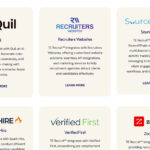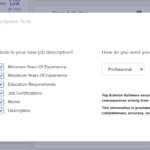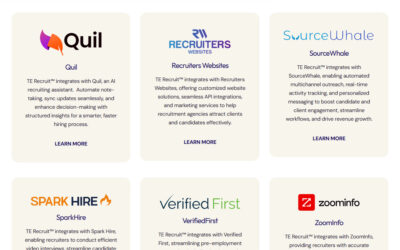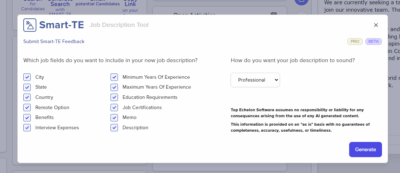In a candidate-driven market, recruiting top talent requires a strategic and well-executed approach. After laying the groundwork through strategic planning, determining hiring needs, and implementing both internal and external recruiting strategies, the final and most decisive step is making the final selection. This critical phase is where all the preparation, screening, and interviewing efforts come together to identify and secure the best candidate for your organization.
In this article from Top Echelon Recruiting Software, we will present five strategies for effective recruiting in a candidate-driven market:
Making the Final Selection: Laying the Groundwork
Before the prescreening process begins, it’s essential to understand your role as a recruiter or hiring professional: you are the expert on market conditions. In a candidate-driven market, the demand for skilled talent often exceeds supply, and it is your responsibility to educate hiring managers on the dynamics of this environment. Many hiring managers, especially those who rarely participate in recruitment, may not be fully aware of these trends.
By providing insights into current market conditions, including candidate availability, compensation benchmarks, and competitive pressures, you can set realistic expectations for the hiring process. This step will help ensure that everyone is aligned from the start, making the entire process smoother and more efficient.
Preparing for the Interview: Timeliness vs. Quality of Hire
In a candidate-driven market, speed is critical. Top candidates are frequently interviewing with multiple companies, and the organization that moves the quickest often wins. However, speed should never compromise the quality of your hire. Making a rushed decision can lead to a poor hire, which is costly in terms of time, money, and morale.
When balancing the need for speed with the need for quality, consider the following:
- Avoid Unnecessary Delays: Streamline your internal processes to avoid delays. Ensure that your interview schedules are set in advance, your decision-makers are prepared, and you have a clear plan for moving forward as soon as you identify a suitable candidate.
- Consider Interim Solutions: If a role must be filled immediately and finding the right permanent candidate will take time, consider hiring a temporary or contract employee. This approach allows you to keep operations running smoothly while you continue the search for a long-term solution.
- Ensure Readiness for Onboarding: Never bring on a new hire if you are not prepared to support them effectively. The first six months are critical for a new employee to decide if they have made the right choice. If you cannot provide proper training, mentorship, and resources, it may be better to delay hiring until you are ready to do so.
Building the Right Interview Team: A Balanced Approach
As you prepare for final interviews, assembling the right interview team is crucial. The team should include key decision-makers who can provide diverse perspectives on the candidate’s potential fit within the organization. Typically, this team should consist of:
- The Hiring Manager: This person understands the role’s requirements and will manage the new hire directly.
- Their Manager: This person can provide a broader view of how the new hire fits into the department’s long-term goals.
- Peers and Colleagues: One to three colleagues who will work closely with the candidate and have a vested interest in their success.
Having too few interviewers may result in a narrow perspective and an incomplete evaluation of the candidate. On the other hand, having too many interviewers can create a cumbersome process that may delay the hiring decision. Striking the right balance is key to gathering comprehensive feedback while maintaining efficiency.
For longer interview sessions, consider incorporating informal interactions, such as a lunch or a tour with a potential peer. These settings allow candidates to ask candid questions and gain a more genuine understanding of the organizational culture, providing valuable insights beyond the formal interview process.
Clarifying Expectations with the Interview Team
Before the interviews, ensure all interview team members are aligned on what you seek in the ideal candidate. A clear understanding of the required competencies, experience, and cultural fit is essential to prevent any misalignment in evaluating candidates. Review the job description and highlight key attributes or skills that the ideal candidate must possess.
Conduct a briefing session to discuss these attributes and any specific questions that interviewers should ask to assess them. Encourage interviewers to focus on core competencies and avoid subjective biases. Providing a structured interview guide can help standardize the interview process and ensure all candidates are evaluated consistently.
Conducting the Interview: Consistency is Key
During the interviews, consistency is paramount. Develop a set of structured questions that align with the job description and core competencies required for the role. Structured interviews are proven to be more effective in predicting job performance than unstructured interviews because they provide a standardized method for evaluating candidates.
Ensure that every interviewer sticks to these prepared questions and scores candidates accordingly. This structured approach ensures fairness and minimizes bias, allowing candidates to demonstrate their qualifications on a level playing field. Moreover, structured interviews provide a documented record of the decision-making process, which can be valuable in defending against potential legal claims of discrimination or bias.
Integrating Assessments into the Interview Process
If you are using psychometric or simulation assessments as part of your evaluation, incorporate them seamlessly into your interview process. These tools can provide deeper insights into a candidate’s cognitive abilities, personality traits, and suitability for the role. Discuss assessment results with the interview team and use them to guide your questioning, focusing on areas where the candidate may need further clarification or exploration.
Debriefing After Interviews: A Critical Step
Once all interviews have been conducted, schedule a debriefing session with the interview team to discuss each candidate. This conversation is vital for reaching a consensus on the best candidate. However, it is also important to be mindful of potential biases that can affect the decision-making process:
- Recency Bias: Interviewers may favor candidates who were interviewed most recently simply because the conversation is fresh in their minds. Ensure decisions are based on documented scores and notes rather than on memory alone.
- Halo Effect: This bias occurs when one positive attribute of a candidate disproportionately influences the overall assessment, potentially overshadowing other, less favorable attributes. Encourage interviewers to consider the whole picture and avoid overvaluing a single characteristic.
- Horns Effect: Conversely, the Horns Effect occurs when one negative trait unduly influences the interviewer’s perception of the candidate, leading to an unfairly negative evaluation. Balance this by focusing on all aspects of the candidate’s profile.
- Cloning Effect: Sometimes, interviewers are drawn to candidates who remind them of themselves, which can cloud judgment. Encourage interviewers to assess candidates based on objective criteria rather than perceived similarities.
- Familiarity Bias: A candidate referred by a high-performing employee or who is a relative may receive undue credit. Ensure that every candidate is evaluated on their own merits.
- Likeability Bias: While it is natural to be drawn to likable individuals, this does not necessarily mean they are the best fit for the role. Distinguish between a candidate’s likability and their ability to perform in the job.
By addressing these biases, you create a more objective and balanced evaluation process, leading to better hiring decisions.
Making the Offer: Crafting a Compelling Proposition
After evaluating the candidates, you should have a clear first choice and a strong second choice in mind. If your first choice does not accept the offer, having a backup candidate ensures that you do not have to restart the process from scratch. However, it is crucial to ensure that your second choice is someone you are genuinely confident in hiring.
When drafting the offer, remember that you are selling your organization to the candidate just as much as they are selling themselves to you. In a candidate-driven market, top talent often has multiple offers. Highlight what makes your organization unique and attractive. Listen carefully to what the candidate has expressed they are looking for in their next career move, and emphasize how your company can meet those needs.
Negotiating the Offer: Flexibility and Clarity
Negotiating an offer can be one of the most delicate parts of the hiring process. Be prepared to negotiate on salary, benefits, remote work options, professional development opportunities, and other factors important to the candidate. Flexibility is key, but ensure that you stay within your organization’s compensation guidelines and policies.
Communicate clearly what the candidate can expect next. Outline any steps that may need to be completed before their start date, such as background checks, reference checks, or other pre-employment screenings. Providing this information up front demonstrates transparency and builds trust.
Engaging and Retaining Top Talent Post-Offer
Once the candidate accepts the offer, keep the momentum going by engaging them immediately. Send a welcome package with information about the organization, team members, and the onboarding process. Maintaining regular communication between the offer acceptance and the start date helps reduce the risk of candidate drop-off and reinforces their decision to join your team.
Final Thoughts: Mastering Recruitment in a Candidate-Driven Market
Recruiting in a candidate-driven market requires a strategic, informed, and agile approach. By educating hiring managers, preparing thoroughly, conducting structured and consistent interviews, avoiding biases, and making compelling offers, you position your organization to attract and retain top talent.
If you’re looking for advanced tools and solutions to support your recruitment efforts, consider leveraging the capabilities of Top Echelon Software. Top Echelon offers a comprehensive suite of recruitment software features designed to streamline the hiring process, improve candidate engagement, and enhance decision-making. From robust applicant tracking to seamless integrations and advanced AI-driven tools, Top Echelon can help elevate your talent acquisition strategy to new heights.
Take the next step today—contact Top Echelon Software to schedule a demo and discover how our solutions can transform your recruiting process, helping you secure the best candidates and drive your organization’s success in today’s competitive job market.








